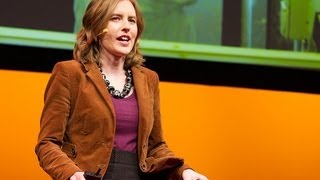(单词翻译:单击)
Have you ever wondered what is inside your dental plaque? Probably not, but people like me do.
你是否曾经好奇过你的牙垢里有些什么成分?你可能从未好奇过,但像我这样的人却会思考这个问题。
I'm an archeological geneticist at the Center for Evolutionary Medicine at the University of Zurich,
我是个考古遗传学家,在苏黎世大学的进化医药中心工作,
and I study the origins and evolution of human health and disease
我研究的是人类健康和疾病的根源以及进化,
by conducting genetic research on the skeletal and mummified remains of ancient humans.
这要通过进行关于远古人类的骨骼和干尸的遗传研究。
And through this work, I hope to better understand the evolutionary vulnerabilities of our bodies,
通过这项工作,我希望能更好地领会人类身体的进化脆弱性,
so that we can improve and better manage our health in the future.
以便我们改善并在将来更好地管理我们的身体健康。
There are different ways to approach evolutionary medicine, and one way is to extract human DNA from ancient bones.
研究进化医药有不同的方法,其中一种是从远古人类的骨头上提取DNA。
And from these extracts, we can reconstruct the human genome at different points in time
从这些提取物当中,我们可以重建在不同时间点的人类基因组,
and look for changes that might be related to adaptations, risk factors and inherited diseases.
寻找可能与适应风险因素和遗传疾病相关的变化。
But this is only one half of the story.
但这只是故事的一半。
The most important health challenges today are not caused by simple mutations in our genome,
当今最重大的健康挑战,并不是由人类基因组中的一些简单突变造成的,
but rather result from a complex and dynamic interplay between genetic variation, diet, microbes and parasites and our immune response.
而是源于遗传变异、饮食、微生物和寄生虫,以及我们的免疫反应之间的一种复杂而有活力的相互作用。
All of these diseases have a strong evolutionary component
所有这些疾病都有一个很强的进化成分,
that directly relates to the fact that we live today in a very different environment than the ones in which our bodies evolved.
它与一个事实直接相关,即我们如今生活在一个跟过去截然不同的环境中,而我们的身体正是在过去的环境中进化的。
And in order to understand these diseases,
为了理解这些疾病,
we need to move past studies of the human genome alone and towards a more holistic approach to human health in the past.
我们需要带着过去对人类基因组的研究一起,向一个更加整体的方向前进,来研究过去的人类健康状况。
But there are a lot of challenges for this. And first of all, what do we even study?
但是我们面临诸多挑战。首先,我们的研究对象是什么?
Skeletons are ubiquitous; they're found all over the place.
骨骼随处可见,到处都可以找到。
But of course, all of the soft tissue has decomposed, and the skeleton itself has limited health information.
但是所有的软体组织都腐坏了,而骨骼本身所携带的健康信息是很有限的。
Mummies are a great source of information, except that they're really geographically limited and limited in time as well.
干尸是一个很好的信息来源,除了一点,他们受到地域的限制,也受时间的限制。
Coprolites are fossilized human feces, and they're actually extremely interesting.
粪化石是人类排泄物的化石,实际上,它们很有意思。
You can learn a lot about ancient diet and intestinal disease, but they are very rare.
你可以从中了解很多古代饮食和肠道疾病的信息,但它们很稀少。
So to address this problem, I put together a team of international researchers in Switzerland, Denmark and the U.K.
所以为了解决这个问题,我组织了一队国际研究学者,他们来自瑞士,丹麦和英国,
to study a very poorly studied, little known material that's found on people everywhere.
来研究一种所知甚少的材料,从各地的人身上都可以找到。
It's a type of fossilized dental plaque that is called officially dental calculus.
它是一种牙垢化石,官方说法是dental calculus(牙垢)。
Many of you may know it by the term tartar.
你们中很多人可能通过牙石这个术语而对牙垢有所了解。

It's what the dentist cleans off your teeth every time that you go in for a visit.
牙垢就是每次你去看牙,牙医从你的牙齿中清除的东西。
And in a typical dentistry visit, you may have about 15 to 30 milligrams removed.
在一次典型的看牙过程中,你可能会被清除15到30毫克的牙垢。
But in ancient times before tooth brushing, up to 600 milligrams might have built up on the teeth over a lifetime.
但是在古代,在有刷牙行为之前,人的一生中在牙齿上可能会积累至多600毫克的牙垢。
And what's really important about dental calculus is that it fossilizes just like the rest of the skeleton,
牙垢之所以重要的原因是它就像其他骨骼一样可以变成化石,
it's abundant in quantity before the present day and it's ubiquitous worldwide.
在过去,它的数量很丰富,在世界上随处可见。
We find it in every population around the world at all time periods going back tens of thousands of years.
我们在全球各个国家的人口中都能找到牙垢,其时间段可追溯到千万年以前。
And we even find it in neanderthals and animals.
我们甚至在尼安德特人和动物身上也找到了牙垢。
And so previous studies had only focused on microscopy.
因此之前的研究仅仅关注了显微镜学。
They'd looked at dental calculus under a microscope, and what they had found was things like pollen and plant starches,
它们在显微镜下观察牙垢,它们发现了花粉和植物淀粉,
and they'd found muscle cells from animal meats and bacteria.
它们从动物的肉和细菌中发现了肌细胞。
And so what my team of researchers, what we wanted to do, is say,
所以,我的研究小组想要做的是,
can we apply genetic and proteomic technology to go after DNA and proteins,
是否能应用遗传和蛋白质组学技术,来跟踪DNA和蛋白质,
and from this can we get better taxonomic resolution to really understand what's going on?
从这一点出发,我们是否能够得到更好的分类学的解决方案来真正理解目前的状况?
And what we found is that we can find many commensal and pathogenic bacteria that inhabited the nasal passages and mouth.
我们发现,我们可以找到很多共生体和病原细菌,它们位于鼻腔通道和嘴巴里。
We also have found immune proteins related to infection and inflammation and proteins and DNA related to diet.
我们也找到了关于感染和炎症的免疫蛋白,以及与饮食有关的蛋白质和DNA。
But what was surprising to us, and also quite exciting, is we also found bacteria that normally inhabit upper respiratory systems.
但是令我们感到奇怪和兴奋的是,我们也发现了通常位于上呼吸道系统的细菌。
So it gives us virtual access to the lungs, which is where many important diseases reside.
所以它给了我们接触肺部的虚拟途径,而肺正是感染很多重要疾病的部位。
And we also found bacteria that normally inhabit the gut.
我们也找到了通常位于肠道的细菌。
And so we can also now virtually gain access to this even more distant organ system that, from the skeleton alone, has long decomposed.
所以我们现在也可以虚拟地接触到这个隔得更远的器官系统,而从骨骼本身来说,这个系统早就腐化了。
And so by applying ancient DNA sequencing and protein mass spectrometry technologies to ancient dental calculus,
因此,通过对牙垢应用古代DNA排序和蛋白质谱技术,
we can generate immense quantities of data
我们可以获得大量的数据,
that then we can use to begin to reconstruct a detailed picture of the dynamic interplay between diet, infection and immunity thousands of years ago.
我们可以用这些数据来开始重建千万年前饮食、感染和免疫之间富有活力的相互作用。
So what started out as an idea, is now being implemented to churn out millions of sequences
所以起初的想法,现在已经被付诸实施来做出数百万的排序,
that we can use to investigate the long-term evolutionary history of human health and disease,
我们可以用这些排序来调查人类健康和疾病的长期进化史,
right down to the genetic code of individual pathogens.
一直到个体病原体的遗传密码。
And from this information we can learn about how pathogens evolve and also why they continue to make us sick.
从这个信息中,我们可以学到病原体是如何进化的,以及为什么它们能够一直让人生病。
And I hope I have convinced you of the value of dental calculus.
我希望我已经说服了你们关于牙垢的价值。
And as a final parting thought, on behalf of future archeologists,
最后,我想要代表未来的考古学家,
I would like to ask you to please think twice before you go home and brush your teeth. Thank you.
请求你们在回家刷牙之前,三思而后行。谢谢。


